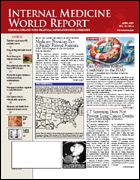Publication
Article
Internal Medicine World Report
You Can Pry a Few More Bucks Out of Medicare
Author(s):
PQRI: Internists Need to Report on 3 Measures Only to Qualify
Dr Rogers is Medical Officer, Office of the Administrator, and Director, Physicians Regulatory Issues Team, Centers for Medicare & Medicaid Services, Department of Health and Human Services.
I?dare say that every physician in the United States is aware that the Medicare program pays doctors in 2007 less than it did in 2001. Physician expenses have been increasing annually?office rent, staff salaries, and malpractice insurance premiums increase every year. What in the world are the bureaucrats who run Medicare thinking?
When the Medicare program was established in 1965, spending on physician services was modest, and local fee schedules were the rule. As the Figure shows, Medicare spending grew dramatically over the next decade, and in 1975 Congress intervened, limiting physician fee schedule increases to the rate of growth of the Medicare Economic Index. Spending continued to increase, and by 1984 Congress actually froze physician fee increases.
In 1987, 1992, and 1997, Congress imposed mathematical formulas that were intended to rein in physician spending. The last of those formulas, called the sustainable growth rate (SGR), has determined the physician fee schedule since 1997. The SGR formula prevents spending on physician services from growing much faster than real per capita gross domestic product (GDP). Because of the very rapid growth in spending on chemotherapeutic drugs and on imaging studies, as well as a more modest but very real growth in volume of other physician office services, the amount of money in the Medicare Part B pie available to pay physicians for an office visit has shrunk considerably.?
The SGR formula has dictated a reduction in the physician fee schedule every year since 2001. Congress has intervened every year, except in 2002, to prevent the negative update, but the formula remains on the law books, and the Centers for Medicare & Medicaid Services (CMS) has predicted that in 2008 physician payments will have to be reduced by 9.9%.
Congress is exploring alternatives to the SGR, but the budgetary implications are sobering. Just to freeze physician fees for the next 10 years would increase Medicare spending by $171 billion. Allowing physician spending to increase at the rate of the Medicare Economic Index for the next 10 years would cause Medicare spending to increase by $252 billion.
There is an opportunity for physicians to pry a few more dollars out of the Medicare program without worrying about spending time in the local pokey. This opportunity is known as the Physician Quality Reporting Initiative (PQRI). Congress has allocated money to be awarded to physicians who participate in this program, by reporting on quality measures to CMS.
Physicians should think about participating in the PQRI. Measure reporting begins on July 1, 2007, and the measures are reported on the Medicare claim form that the office generates already. Physicians who participate will get a check from Medicare, as well as a confidential report, which will give the reporting physicians a sense of their personal performance.
Unlike the hospital quality measures, physician measures will not be disseminated to the public. There are currently 74 measures, but internists will only need to report on 3 measures to qualify for the payment.
We hope to have the detailed specifications of the measures on the PQRI website by the time you read this. As soon as the specifications are available, it will be a simple matter for a practice to develop a worksheet listing just the measures that that practice has elected to report.
If, for example, the practice decided to report on hemoglobin (Hb) A1c measurement in their diabetic patients, the worksheet would list the CPT II code for that measure, and the doctor would check the box if she or he had measured the HbA1c.
When the chart is processed by the billing staff, they need merely add that CPT II code to the claim form on line 24.
We would encourage physicians with questions to call in on the next physician open-door forum.






